Blog
The fundamentals of stakeholder strategy
A practical guide to tailored stakeholder management, offering strategies and tools to identify, map, and nurture relationships.
Who’s shaping the conversation around the 2025 federal budget—traditional media or the public? News coverage has framed the budget through a global lens, linking economic policy to Donald Trump, NATO spending, and deregulation. But on social media, the focus is closer to home. Early discussions revolved around tax cuts and cost-of-living relief before shifting to Medicare funding, public service job cuts, and the real-world impact of budget decisions.
This divide reveals a growing disconnect between political narratives and public concerns. While news dissects party strategy and fiscal responsibility, online conversations highlight frustration over essential services and household finances. As the budget approaches, the real question is: Will media framing or public sentiment ultimately shape how Australians respond?
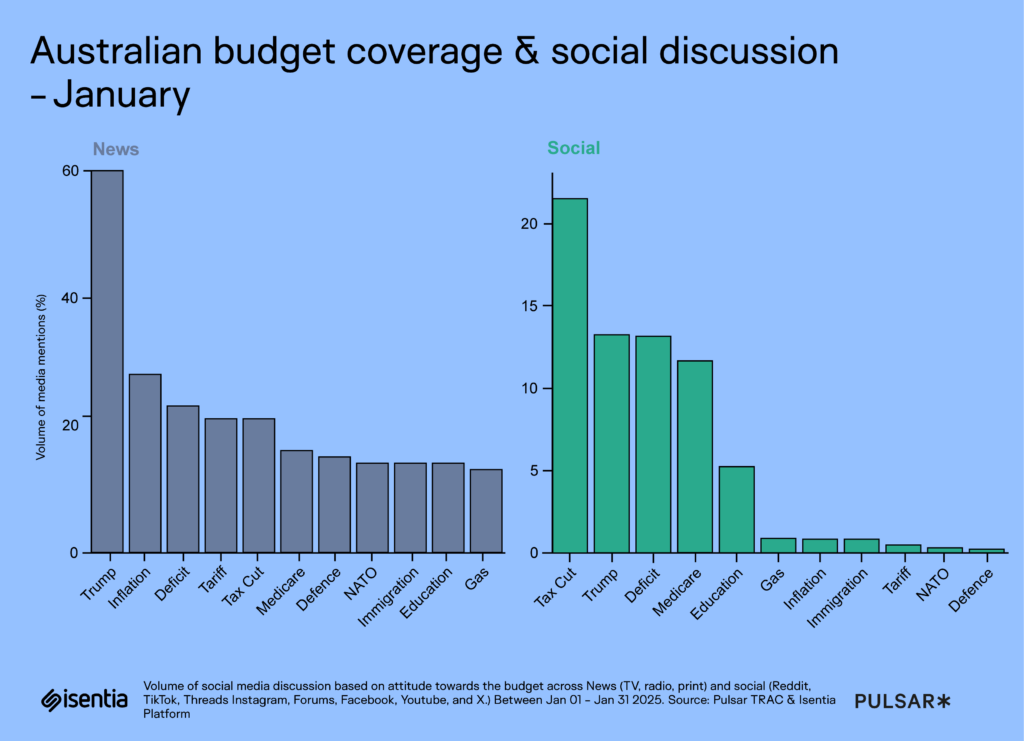
In January 2025, the Australian federal budget was shaped by how media coverage highlighted global influences, particularly Donald Trump’s calls for NATO defence spending increases, framing Australia’s defence and trade priorities. The Australian Strategic Policy Institute argues Australia must “do more, spend more, risk more” in response to global threats, shaping debates within the Coalition. However, social media discussions focus more on direct budget impacts, particularly tax cuts and cost-of-living concerns. News outlets like The Australian and Herald Sun cover the growing budget deficit and fiscal responsibility, but social media sees widespread criticism of tax cuts, seen as election tactics without addressing inflation and essential services.
Public discussion is more engaged in how the budget affects areas like cost of living pressures like healthcare and education, with Channel 7 Sunrise and Weekend Australian reporting on inflation and its link to energy security. Social media engagement on Trump’s influence is secondary to local concerns, such as “bracket creep” and rising bills, reflecting a shift away from global issues like NATO, which are less discussed compared to the deficit and inflation impacts. This shows how social media conversations are focused on tangible, personal consequences, contrasting with news coverage that intertwines global and domestic policy discussions.
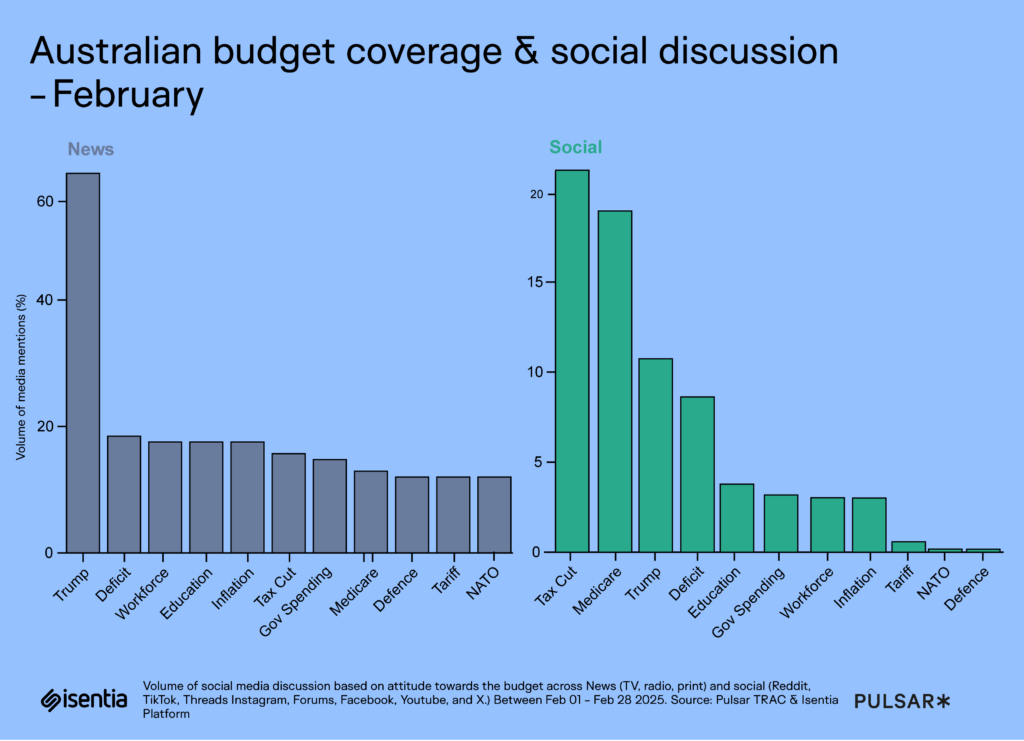
In February 2025, federal budget coverage often referenced Donald Trump’s economic policies, with references to comparing the Business Council of Australia’s tax cut push to Trump’s pro-business, deregulation agenda. Commentary like Ross Gittins’ SMH piece, discusses reduced government spending and red tape to similar policies abroad. On social media, tax cuts dominated early discussions, with many arguing the opposition’s focus on cuts and deregulation echoed past policies that ignored inflation and wage stagnation. Labor’s staged approach—tackling inflation before tax relief and healthcare investment—was seen by some as pragmatic, while others dismissed it as political manoeuvring. Comparisons to Trump-era tax cuts emerged, with debate over whether similar policies would work in Australia.
As the conversation evolved, Medicare and healthcare funding took centre stage, drawing more attention than Trump or the budget deficit in news coverage. Viral posts criticised past Coalition cuts to Medicare, bulk billing, and aged care, warning of further reductions under Peter Dutton. Others pointed to his past role in Coalition health policies, questioning his commitment. Job cuts to public services were also a concern, with warnings of delayed Medicare processing and added pressure on frontline healthcare workers. While news coverage framed the budget around political strategy and fiscal policy, social media reflected shifting anxieties—first tax cuts, then healthcare access and economic fairness.
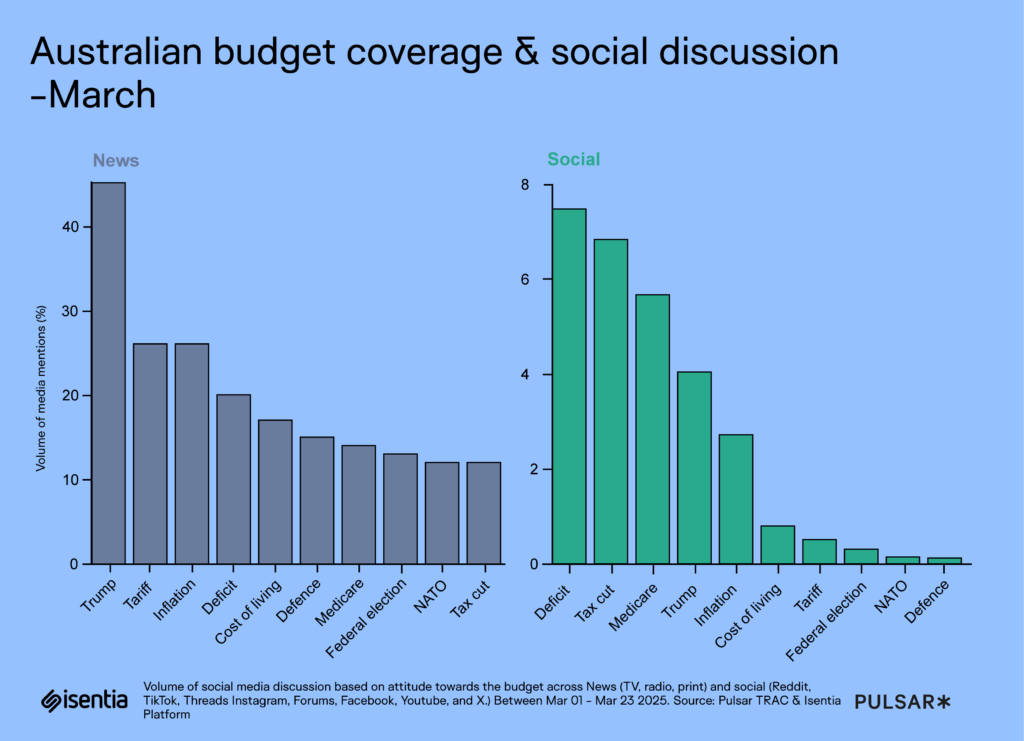
In March 2025, media coverage of the Australian federal budget has centred on the impact of Donald Trump’s tariffs, with news outlets highlighting concerns over trade tensions and their effect on Australia’s economy.
On social media, the focus has shifted to domestic issues like tax cuts, the budget deficit, and cost-of-living relief. Reports from Crikey and ABC News on the budget deficit have sparked social media debates about the sustainability of the government’s financial strategy. While some defend Labor’s post-COVID measures, including a $1.8 billion energy rebate, others criticise the government’s handling of inflation and the deficit. Social media reactions are more focused on domestic policy choices than global trade concerns, often reflecting more critical and emotionally charged reactions to leadership and policy, contrasting with the neutral, policy-focused tone of traditional news. The coverage also shows how economic issues are framed differently, with media offering analysis and social platforms fostering more polarised debates, suggesting the growing influence of grassroots concerns in shaping political discourse.
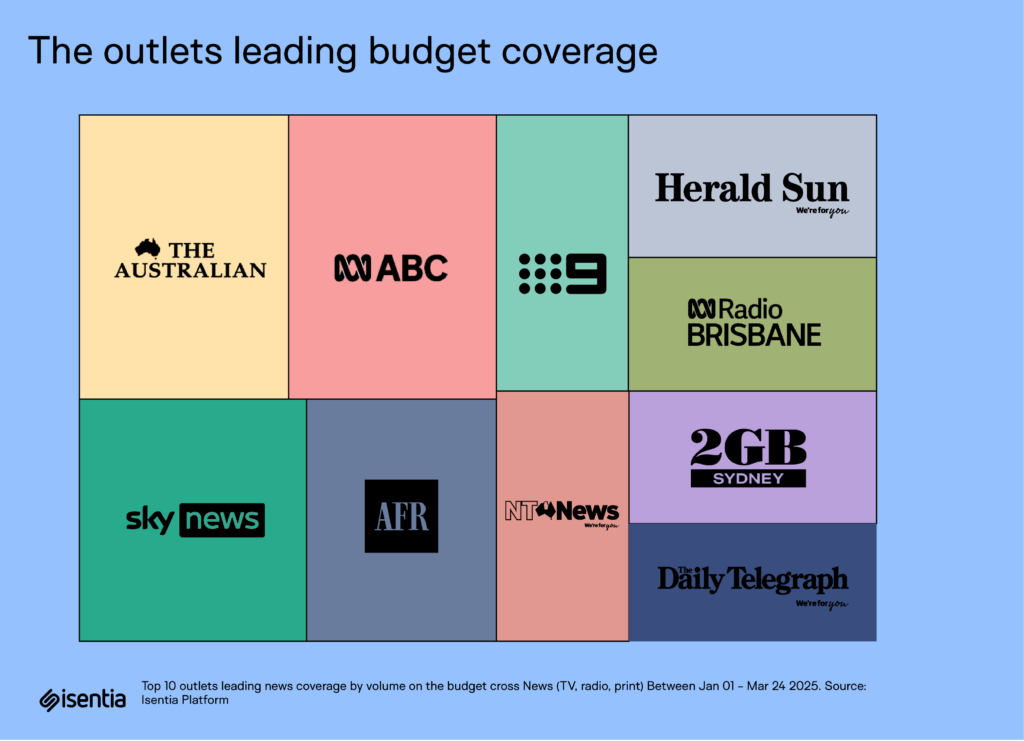
The Australian and ABC News set the agenda for this year’s federal budget coverage, shaping how key issues are framed for the public. Some leading stories published by The Australian centres on Coalition divisions, portraying the budget as a test of Peter Dutton’s leadership amid concerns over a weak economic agenda. MPs warn that an overemphasis on public service cuts and a lack of compelling policies—particularly on cost-of-living relief like energy rebates—could undermine voter confidence. The coverage highlights the Coalition’s struggle to present a credible alternative to Labor while managing internal pressure to adopt bolder economic policies.
ABC News, meanwhile, leads with the direct impact of the budget on households, reporting on electricity price hikes and their uneven regional effects. It also broadens the discussion by linking fiscal policy to social outcomes, with one popular story focusing on the Productivity Commission’s report on rising Indigenous incarceration rates reinforcing the stakes of government spending choices. This contrast in coverage underscores how print media frames the budget as a political contest, while broadcast news tends to focus on its real-world consequences.
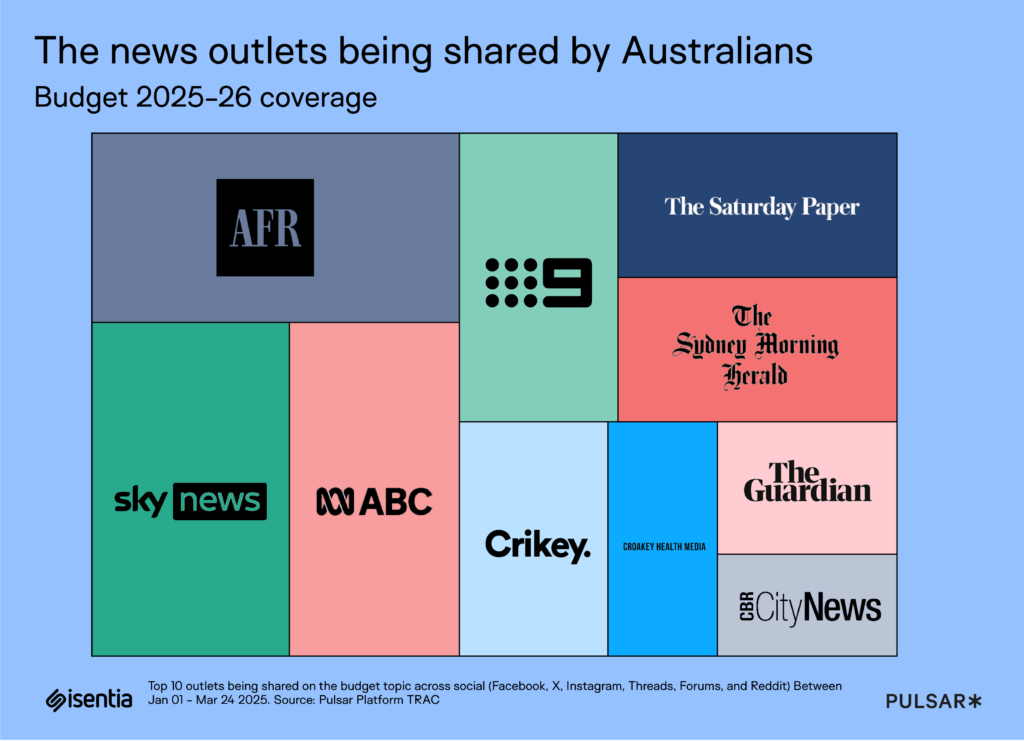
The high engagement across news outlets such as ABC, Australian Financial Review, Crikey, The Saturday Paper, The Sydney Morning Herald, and 9News highlights a clear audience focus: A widely shared ABC article highlights how the Albanese government plans to address rising costs with energy bill relief, resonating with audiences concerned about personal finances. Crikey’s commentary on the political clash between Labor and the Coalition, particularly over spending commitments, engages audiences with broader political implications. Similarly, the Sydney Morning Herald focuses on surprise revenue gains and potential energy relief, speaking to voters affected by rising electricity costs.
Audiences appear particularly engaged by news that ties political decisions directly to their personal and family financial realities—whether through energy cost relief, healthcare funding, or discussions around budget deficits. The framing of economic policies as part of an election strategy intensifies political rivalry, especially with stories positioning the Coalition’s fiscal responsibility as a counter to Labor’s spending.
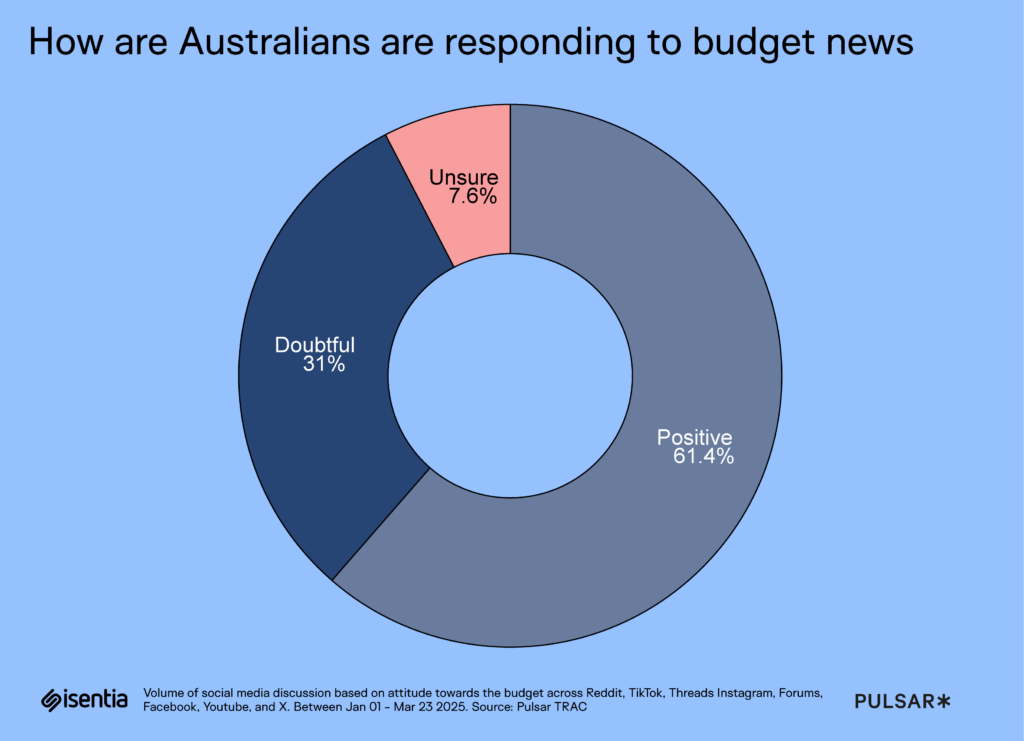
Social discussion reflects a positive outlook on the Labor budget, highlighting confidence in the government’s actions, particularly in disaster relief and economic recovery. Supporters see the budget as a chance to showcase progress, with a focus on strengthening the safety net and easing cost-of-living pressures. However, scepticism remains over wage growth, spending priorities, and whether rising defence costs align with immediate domestic needs. This tension underscores a broader divide in Australian perspectives—between those who view the budget as reinforcing long-term progress and those who question whether media narratives either overstate recovery or fail to scrutinise key trade-offs. The debate also signals a pushback against selective media framing, as Australians navigate between government messaging and critical scrutiny of economic challenges.

Engagement with budget discussions on social media shows how politicians, journalists, and the public interact. Labor politicians use social media to promote the budget and counter opposition views, while political enthusiasts offer independent analysis. Journalists from outlets like Crikey and News.com.au provide investigative insights. Political influencers, with strong ideological leanings, generate engagement through hyperbolic framing, reinforcing confirmation bias. While politicians shape how the budget is understood, media outlets, despite smaller engagement, still play a crucial role in framing key updates, highlighting the fragmented nature of audience reception and the influence of partisan messaging.
The 2025 federal budget debate highlights the growing divide between media narratives and public concerns. While traditional outlets focus on political strategy and fiscal policy, social media engagement reveals a stronger emphasis on tax cuts, Medicare, and cost-of-living relief. This shift underscores the need for messaging that resonates with lived experiences.
As election season approaches, the question remains: Will political leaders adjust their approach to reflect public sentiment, or will the disconnect between media coverage and voter priorities continue to shape the debate?
Loren is an experienced marketing professional who translates data and insights using Isentia solutions into trends and research, bringing clients closer to the benefits of audience intelligence. Loren thrives on introducing the groundbreaking ways in which data and insights can help a brand or organisation, enabling them to exceed their strategic objectives and goals.
A practical guide to tailored stakeholder management, offering strategies and tools to identify, map, and nurture relationships.
Across the communications landscape, teams are being asked to do more with less, while staying aligned, responsive and compliant in the face of complex and often shifting stakeholder demands. In that environment, how we track, report and manage our relationships really matters. In too many organisations, relationship management is still built around tools designed for […]
Get in touch or request a demo.